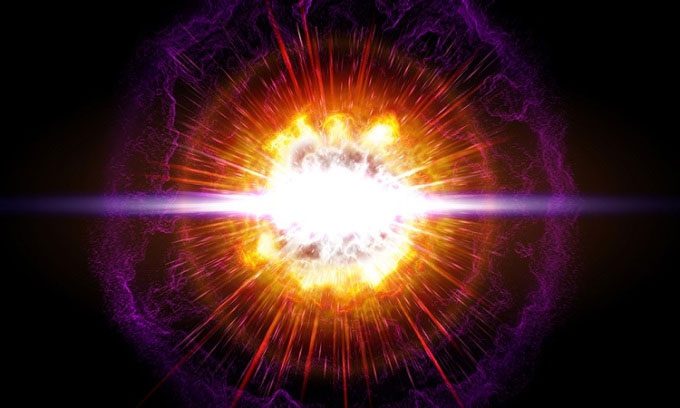A supernova is an explosion that releases an enormous amount of energy and brightness, outshining entire galaxies containing hundreds of billions of stars.
Astronomers Walter Baade and Fritz Zwicky coined the term “supernova” to describe the remnants of a neutron star in 1933, according to Popular Mechanic. Prior to this, the astronomical community referred to all ancient explosive objects in the sky as “nova,” which means “new” in Latin. Supernova explosions can be categorized into two main types, each with entirely different conditions and mechanisms at play. The first type is a Type II supernova, which involves core collapse. These occur when a massive star approaches the end of its life cycle.

Simulation of the brightest supernova SN2016aps in a galaxy 4.6 billion light-years from Earth. (Image: iStock)
Every star in the universe fuses elements in its core throughout its lifecycle, from the smallest stars that are merely 1/10 the mass of the Sun to those that are 100 times its mass. They primarily fuse hydrogen into helium for most of their existence. Sun-like stars can last about 10 billion years before entering the final phase, expanding into red giants. However, the largest stars, with immense gravitational forces compressing their cores, will exhaust their hydrogen reserves in just a few million years.
After depleting hydrogen, the massive star begins to fuse helium into carbon and oxygen, followed by silicon and magnesium. Ultimately, it creates a core of nickel and iron. Just before its death, the star resembles a swollen monster. Its outer atmospheric layers completely detach. Inside, the star resembles an onion, with an iron core surrounded by layers of lighter elements.
Each stage in a star’s life cycle is shorter than the previous one. A star quietly burns through its hydrogen for millions of years and fuses helium in less than a million years. It can sustain carbon fusion for about 1,000 years. The products of fusion with iron in the core last a total of 15 minutes. All stars with masses between 8 and 200 times that of the Sun undergo this same process.
Iron fusion does not produce any energy. Instead, it consumes energy to fuse iron into heavier elements. The rest of the star continues to collapse into the core, but without any energy released from thermonuclear reactions to restore balance. The entire mass of the star compresses the core so tightly that iron atoms rearrange themselves, with electrons moving into protons, transforming the entire mass of iron into a massive neutron star.
When the neutron star can no longer withstand the compression, all remaining material from the star crashes into it and bounces back, triggering the supernova explosion. In less than a second, the entire star explodes from the inside out, sending shock waves through its own material at speeds nearly equal to the speed of light. The radiation accompanying the explosion carries enormous amounts of energy. For instance, the star Betelgeuse, located nearly 650 light-years from Earth, is expected to undergo a supernova explosion in the coming millions of years. When it does, it will be bright enough to be seen during the day, outshining even the full moon.
Fortunately, Earth is not close to any massive stars with unstable outer atmospheres. The radiation and particles emitted from the supernova explosion collapsing into the core would tear everything within a 100-light-year radius into pieces.
Another type of supernova is Type Ia, which is equally deadly. This type of explosion does not come from a solitary dying star but from a scenario where a star consumes its companion. Most stars in the universe exist in pairs. Members of a binary star system never have the same mass. In fact, they often have significantly different masses. They will undergo cycles at different rates, with the heavier star dying first. If that star has a mass comparable to the Sun, it will leave behind a white dwarf, a dense core of carbon and oxygen that has yet to undergo fusion.
Sometimes, the star in the system expands into a red giant. Part of its atmosphere spills over onto the surface of the white dwarf. When the density of that atmosphere reaches a critical threshold, a thermonuclear reaction with hydrogen releases a flash known as a regular nova.
However, under the right conditions, the red giant continuously pours its atmosphere onto the surface of the white dwarf, gradually increasing pressure and temperature. The thick hydrogen atmosphere ignites a thermonuclear reaction that releases all energy at once. The explosion shocks the white dwarf, forcing carbon and oxygen to undergo uncontrollable thermonuclear reactions.
Supernovae are the largest atomic bombs in the universe, objects the size of Earth but with masses greater than the Sun, transforming all of their mass into a nuclear fireball. When they occur, supernova explosions shine brighter than entire galaxies that contain hundreds of billions of stars. However, this display of light does not last forever. Within weeks, the supernova dims and fades, leaving nothing but remnants drifting in interstellar space.
Each galaxy, like the Milky Way, experiences only a few supernova explosions per century, with about one-third of those being Type Ia. If one were to occur too close to Earth, the radiation and shock waves from the supernova would strip away the planet’s atmosphere.





















































